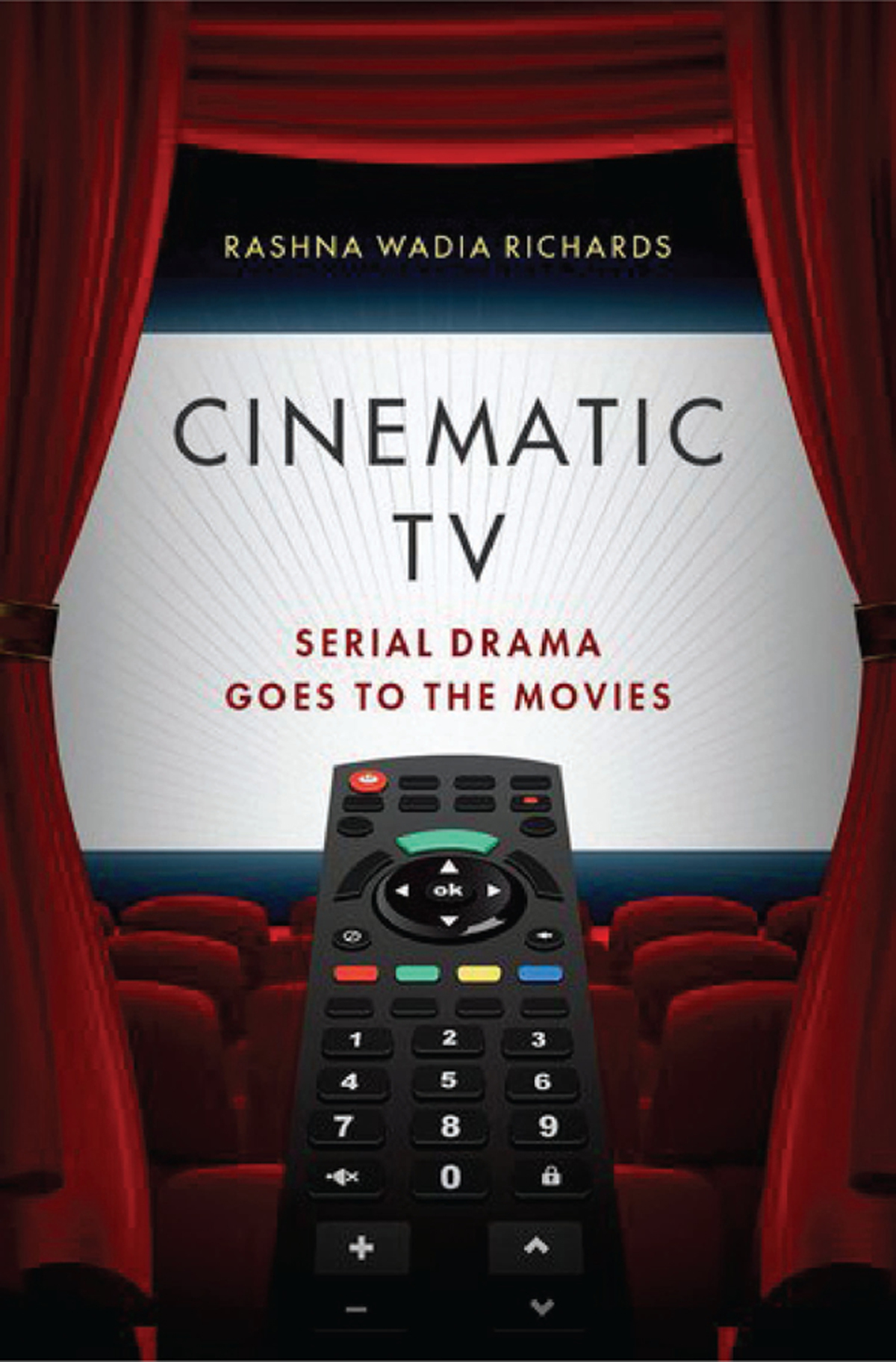Over the past few decades certain scholarly and journalistic media critics have sought to differentiate television worth watching from the otherwise vast wasteland2 of the medium’s offerings. Terms such as “quality TV” and “prestige drama” have been used to describe televisual content that achieved a status beyond those shows that were traditionally part of network and cable programming schedules. When discussing narrative complexity, mise-en-scène, and even audience appeal, the word “cinematic” may be deployed to elevate a program in an attempt to solidify the text as a worthy object of study.3 Nevertheless, simply using the term “cinematic” to describe a TV show may operate as little more than a backhanded compliment. In Cinematic TV: Serial Drama Goes to the Movies Rashna Wadia Richards admits that using “cinematic” to describe television can be “nebulous” and “hyperbolic.” Her monograph then adroitly demonstrates how TV’s “appropriations of cinema”4 provide an opportunity to re-theorize intertextuality and apply it as an analytical method to untangle the “intermedial relationship between cinema and television.”5
Cinematic TV conceptualizes intertextuality through four distinct modes: homagic (chapter 1), evocative (chapter 2), generic (chapter 3), and parodic (chapter 4). In doing so the etymological origin of the terms are precisely and exhaustively traced. Additionally, Richards engages with a variety of historiographic and theoretical discourses common among film and media scholars in a fresh and accessible manner. Each chapter also focuses on a specific text and unpacks how the modes of intertextuality can help clarify the ways in which serial dramas may utilize overtly or subtly visual cinematic references and themes. While Stranger Things is deliberate in its homage to 1980s sci-fi and horror films, Mad Men’s tribute to the 1960s is manifest through “implied [visual] references”6 that are likely unintended. An investigation of Damages focuses less on formal connections to cinema and delves into thematic and generic similarities. In the final chapter Richards complicates traditional, throw-away notions of parody in an analysis of Dear White People. Each of Cinematic TV’s chapters uses an intertextual framework to move beyond outdated, narrow notions of TV as a less worthy object of study than cinema. She makes this argument not by comparing TV to film but by expertly highlighting the way in which visual storytelling, in both film and TV, is and always has been a remediated tapestry of texts.
Cinematic TV meets and exceeds its goal of “developing an expansive framework for analyzing [the relationships between film and serial drama] in ways that are not reductive or evaluative.”7 One of the book’s most useful contributions is the way in which Richards draws on numerous analytical theories and methods to better illustrate the value of her intertextual frame. For example, during Richards’s discussion of homage she notes that the term has been thought to be evaluative in nature especially among those who are invested in auteurism. Paying homage is an attempt to elevate a text while “acknowledging the superiority” of the hypotext.8 Visual references to sequences in Hitchcock films that are recreated in an Amazon streaming series hail the critics and ask them to associate a lower cultural form with a canonical cinematic text. Richards argues, however, that this understanding of homage is incomplete and “surprisingly undertheorized.”9 Yes, homage is an act of deference as Noël Carroll, Richard Dyer, and Thomas Leitch have discussed. But homage10 is more than just an evaluative celebration. An intertextual reference becomes an homage when it is also critical, inversive, and perhaps even subversive.11 Richards illustrates this point through her analysis of Stranger Things:
Contemporary television gazes at the cinematic past unromantically. The reflective distance between serial dramas and their cherished cinematic sources demonstrates [that] … serial dramas reconstruct films in order to show that there is no way to go back. They pay homage to the cinematic past by reflecting on, rather than investing in, the allure of nostalgic fantasy.12
Homage is intentional and direct as in Stranger Things. Mad Men also reportedly employed a list of ten cinematic influences for cast/crew to reference throughout the show’s run. Yet not all allusions to cinema are planned. They are inferred.
In chapter 2, Richards asserts that cinematic references have become “part of the [Mad Men’s] DNA.”13 Mad Men has an unmistakable period look. The lead character, Don Draper, operates as an avatar not of a specific character from a canonical film but as an evocative representation of the cultural shift in mid-twentieth-century America. That is to say, Don Draper’s identity represents the changing nature of American culture as seen on films from the 1950s to 1970s. Richards aims to show how Draper, who is emblematic of a studio era matinee idol, complete with a fictionalized backstory, ultimately ends up vanishing among the rise of New Hollywood and 1960s–1970s counterculture.
Utilizing the evocative mode of intertextuality in an analysis requires a significant mastery of cinematic history and form. It is the most complex of the four modes, but Richards helps to explain how it operates by reminding us that according to postmodernists texts are created by texts. As she asserts in Cinematic TV’s introduction, passive memory allows for that which is absent but not forgotten to haunt a text.14 Viewers may be unaware of what they remember: an item of clothing, a song, or a specific scene from a film they have not seen in years. But when these quasi-forgotten things appear in a television show, they are instantly familiar. Richards’s analysis of Mad Men was the initial inspiration for this project.15 She likely could have provided an even deeper discussion of how Mad Men is “saturated” with cinema in unintended ways, though the chapter is undeniably thorough as is.16
Cinematic TV’s most dynamic section covers the relationships between intertextuality and genre. Among the four modes Richards introduces in her conceptualizations of intertextuality, genre is perhaps the most theorized. Yet Richards presents an intriguing articulation of how genre operates on television. The analysis of Damages in chapter 3 intersects a discussion of narrative complexity and genre with feminist and queer film theory. She calls for more work to be done on how generic hybridity works17 especially within televisual texts. Such an investigation, Richards asserts, would better reveal the connected nature of genre and intertextuality.
In Damages, an overlap of the maternal melodrama, the puzzle film and the legal drama “demonstrate how the notion of genre pivots on the idea of resemblance.”18 Richard’s analysis illustrates how genre and intertextuality should be thought of as entangled. A standout section of chapter 3 is Richard’s discussion of queer temporality in relation to melodrama. The generic expectations are subverted when the characters do not ascribe to gendered notions of life stages. The melodramatic characteristic of maternal sacrifice is disrupted and critiqued when combined with the temporally out-of-sequence puzzle film and legal drama, thereby “mocking narrative neatness.”19 Similar to homage, where intertextuality is conceptualized as more than a loving nod to cinematic hypotexts, generic intertextuality on television is not just about deploying indexes of characteristics or a marketing shorthand. Intertextual genre hybridity is a disruption of expectations. It is a destabilizing critique.
Cinematic TV’s final chapter on parody builds Richards’s argument regarding how intertextuality provides for critique, inversion, and subversion. While chapter 3 focuses on how time operates as a narrative tool, chapter 4 concentrates on space in its analysis of parody. Specifically, Richards is concerned with institutional space as opposed to physical space.20 Where American and European cinema are largely the domain of white masculinity, Dear White People displaces whiteness both in the show’s physical setting and in production norms. African American females occupy two lead roles and play characters attending a majority white university. Richards argues that the show explores the challenges Black students face when navigating collegiate life on a predominately white campus while simultaneously contending with “the difficulties of making an African American show in a traditionally white industry where whiteness is the invisible norm.”21 The parodic intertextual mode “works to depose cultural authority.” Dear White People directly references the work of Godard, Fellini, and Bergman in the mise-en-scène through the character Sam, a young woman who is studying film. Dear White People appropriates canonically white cinematic spaces that have been referenced in countless televisual spoofs. In doing so the American and European film canon is interrogated by inserting Black characters where “whiteness is the norm.”22 Parody then, operates as a “displacement paradigm”23 that cleverly forces viewers rethink how and why the film canon occupies a valorized cultural space.
Scholars have been working to understand the complex, beautiful nature of serial dramas.24 Cinematic TV teases out how television studies in general and intertextual analyses specifically can help scholars better understand the medium of film and its presumed space as a higher cultural form. The book closes with an invitation to rethink criticism in an era when media silos are not as concretely separate as they once were. Finally, Richards is not seeking to prove that the selected serial dramas are good nor is she simply making an index of film’s influences on TV. Rather she is offering a “multilateral”25 route through which critics can traverse the increasingly boundaryless relationship between movies and television.26
Notes
- Maria Suzanne Boyd is an Associate Professor of Communication Studies at Delaware County Community College in Media, Pennsylvania. She teaches several subjects in the field of film and media studies and serves as course advocate for Film Language, American Cinema, New Media & Culture, and Introduction to Mass Communication. Professor Boyd also runs the Delaware County Community College New Media Lab, which produces original digital content. She has contributed to In Media Res and Antenna. ⮭
- The phrase “vast wasteland” is an obvious reference to FCC chair Newton Minnow’s infamous speech that condemned broadcast television. ⮭
- This book exclusively addresses the intertextuality cinema and television serial dramas. Of course media scholars have long been invested in seriously exploring various television formats and genres such as children’s programming, reality television, “trash” TV, and so on. ⮭
- Rashna Wadia Richards, Cinematic TV: Serial Drama Goes to the Movies (New York: Oxford University Press, 2021), 2. ⮭
- Ibid., 10. ⮭
- Ibid., 24. ⮭
- Ibid., 200. ⮭
- Ibid., 32. ⮭
- Ibid., 33. ⮭
- Scholars interested in fan studies may appreciate that Richards also draws on Henry Jenkins and Barbara Klinger to assert that the professional work of homage in serial dramas is analogous to fans’ creative forms such as vidding. ⮭
- Richards, Cinematic TV, 39. ⮭
- Ibid., 64–65. ⮭
- Ibid., 76. ⮭
- Ibid., 79. ⮭
- Ibid., ix. ⮭
- Ibid., 23. ⮭
- Ibid., 124. ⮭
- Ibid., 152. ⮭
- Ibid., 134. ⮭
- Ibid., 157. ⮭
- Ibid., 169. ⮭
- Ibid., 194. ⮭
- Ibid., 23. ⮭
- See the work of Jason Mittel and Greg Smith. ⮭
- Richards, Cinematic TV, 202. ⮭
- For additional reading on how and why serial dramas have been elevated as a cultural form, see Michael Z. Newman and Elana Levine, Legitimating Television: Media Convergence and Cultural Status (New York: Routledge). ⮭


